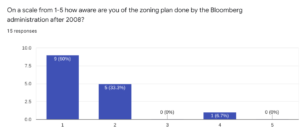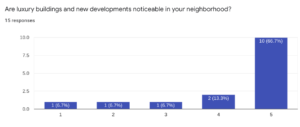![]()





Notable Responses To The Question: Do you think your neighborhood is gentrifying?
- “Yes. Luxury apartments and buildings have been developing more frequently along with high end restaurants and stores that the original local community cannot afford. Additionally, a lot of the culture has been replaced with more modern and americanized establishments because the original people are unable to afford the rising rent.”
- “Traditional shops and restaurants are gone and new non-Chinese establishments replaced them. Prices are rising such as food and beverages. Mix of people living in neighborhood is changing.”
- “Chinatown and the Lower East Side has definitely been gentrifying and the rapid changes are visible to the eyes. There have been more luxurious hotels, art galleries, and big business shops in the area like Target and Trader Joe’s along with the Essex street movie theater. The most obvious change is perhaps the addition of One Manhattan Square that shoots across the sky among NYCHA buildings that are not in any way affordable to low income household that suffers from housing shortage the most. There has also been much more white people in the neighborhood that has historically been home to many people of color and these gentrified buildings are being resided by these newcomers. I live in a building that is gentrified and most of my Chinese neighbors have been evicted or they found themselves rent burdened so they had to leave to a cheaper neighborhood. My family has seen increases in rent every once in awhile since the building was gentrified and we are severely rent burdened. We also don’t have the renovation to our apartments like our wealthier neighbors so there’s that preference of treatment already and everything has become much more expensive in the neighborhood because developers are bringing in shops that the local residents can’t afford. Mayor de Blasio has really pushed for gentrification in his so called rezoning plans to provide affordable housing. He has targeted poor neighborhoods to build affordable housing that don’t end up being affordable for the local residents and then it get rented to the middle class and higher class that just end up pushing for gentrification.”


